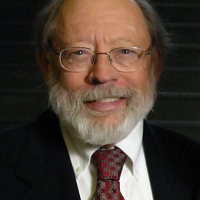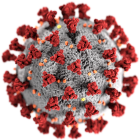“The people had done it themselves”
This springtime an eerie silence has fallen over the world’s cities and towns, as governments order their citizens to stay home, avoid unnecessary travel, and keep away from large-group gatherings. Urban streets, rural highways, brand-new airports, and the new generation of bullet trains are all emptier than before, for they are the dreaded paths that the coronavirus (COVID-19 or SARS-Cov2) takes to spread from continent to continent and reach its next victims.
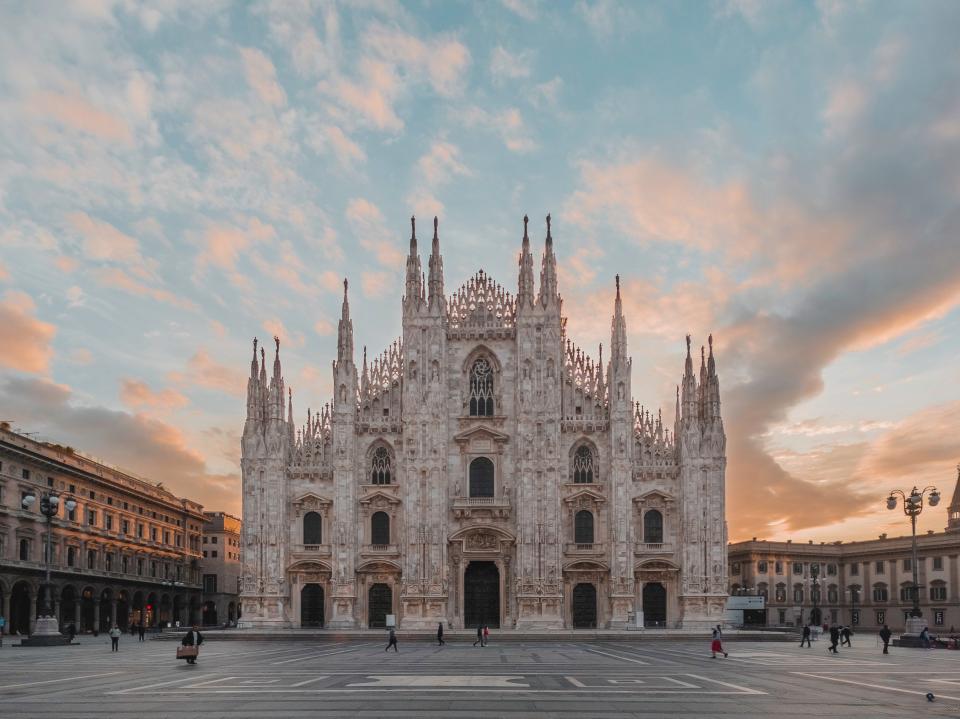
Milan’s Piazza del Duomo during the coronavirus pandemic. Photograph by Ouael Ben Salah.
Milan’s Piazza del Duomo during the coronavirus pandemic. Photograph by Ouael Ben Salah.
Photo by Ouael Ben Salah on Unsplash.
This work is licensed under the Unsplash License.
Other plant and animal species, according to reports, have begun returning to our cities, making a rather unfamiliar noise with their singing and honking. That clamor of geese, woodpeckers, and swans comes from tough and adaptive survivors of a general holocaust that animal species have been going through. They represent the few who have survived, but they should not be taken as signs of a planetary recovery. That process may take thousands, even millions, of years. Industrial civilization, in contrast, will not take so long to recover.
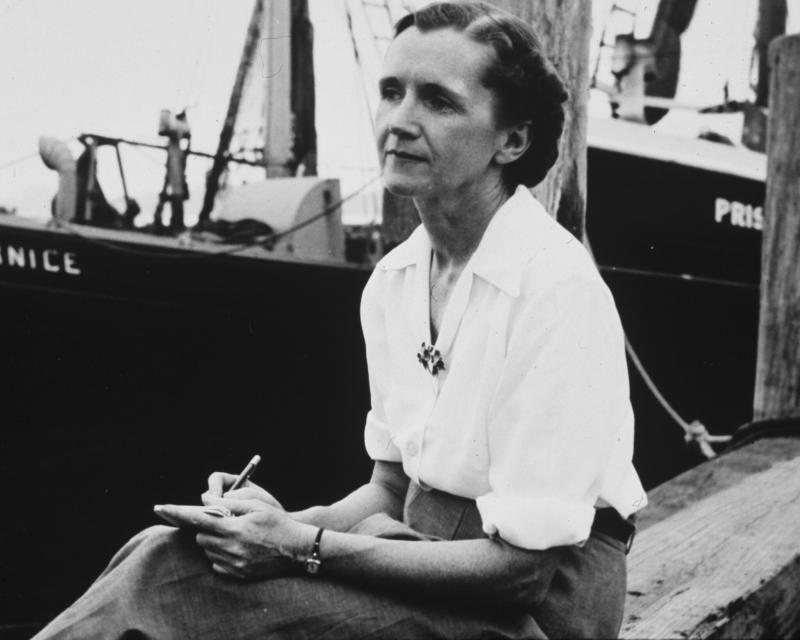
Rachel Louise Carson (1907–1964). Unknown photographer, n.d.
Rachel Louise Carson (1907–1964). Unknown photographer, n.d.
Courtesy of the U.S. Department of Agriculture.
Accessed via Flickr on 14 April 2020. Click here to view source.
 This work is licensed under a Creative Commons Public Domain Mark 1.0 License.
This work is licensed under a Creative Commons Public Domain Mark 1.0 License.
The biologist and writer Rachel Carson opened her world-shaking 1962 book Silent Spring with “a fable for tomorrow”—a future when “some evil spell” had settled on our communities, when “mysterious maladies swept the flocks of chickens; the cattle and sheep sickened and died. Everywhere was a shadow of death.” The cause of her imagined silence was pesticides like DDT, liberally applied to fields and lawns to eradicate the pests and vermin that threatened agricultural production. All-out production was deemed necessary to feed a burgeoning human population and make money for corporations and farmers. Now, six decades later, DDT is no longer used in the United States, although many replacements have been spreading across the land. Throughout Africa, Asia, and Latin America the old poison is still being used to combat insect pests and control diseases. China, for example, last year produced 4,500 metric tons of DDT to kill ticks and mites. And worldwide more than 2.5 million metric tons of biocidal chemicals are being applied to the land each year. That poisonous rain has become much heavier than Carson ever imagined, and it continues to damage the planet’s ecology.
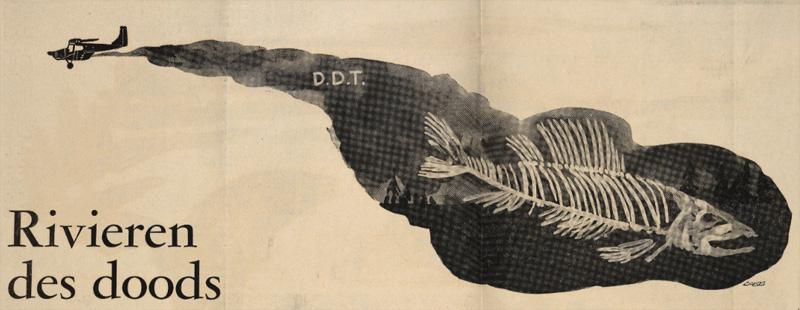
The popular Dutch weekly Elseviers Weekblad serialized selections of Silent Spring over several issues. Elseviers was the only periodical to commission its own illustrations, which were strikingly dramatic and even lurid.
The popular Dutch weekly Elseviers Weekblad serialized selections of Silent Spring over several issues. Elseviers was the only periodical to commission its own illustrations, which were strikingly dramatic and even lurid.
© 1963 Elseviers Weekblad.
Elseviers Weekblad, 4 October 1963, page 51.
Used with permission
The copyright holder reserves, or holds for their own use, all the rights provided by copyright law, such as distribution, performance, and creation of derivative works.
Nor did Carson foresee the new kind of silence we are experiencing. As I said, it comes from a cessation of industrial civilization’s usual screeches, roars, and rumbles. This time the cause is not a biocide but a dangerous virus that has jumped from lower animals, where it first evolved, all the way up to humans. As I write, there are more than two million confirmed cases of COVID-19 infection worldwide—and that has happened in a mere three months. We may have years to wait before a vaccine to stop the virus is available. Thus, the silence spreading across our cities and countryside may reach a deafening silence—one that stops all rational thought.
Replace this dynamic map with Media Atom 6074 (from 19.4.2020) for PDFs or if this image is taken offline at the source.
Speaking of irrationality, some people are calling for nothing less than mass extermination of the guilty animals, just as they did when insects were seen as the great enemy and chlorinated hydrocarbons and organic phosphates became weaponized. Kill the Japanese beetles! Exterminate the Russian thistle! Now the cry is to kill all the bats. Rid the world of viruses and bacteria. Drench the Earth with bleach baths, hand sanitizers, and vaccines. Save civilization from dangerous, out-of-control nature.
There is no shortage of noise when humans begin to panic and shout for revenge. We are in a fighting mood, and the fight once more is against nature. The nonhuman world is being blamed not only for the current wave of sickness but also for upheaval in trade, manufacturing, transportation, jobs, currencies, stock prices, education, climate and biodiversity conferences, immigration, and hospitals. Eventually, after the first waves of panic begin to subside, we may be ready to think about why this epidemic has occurred.
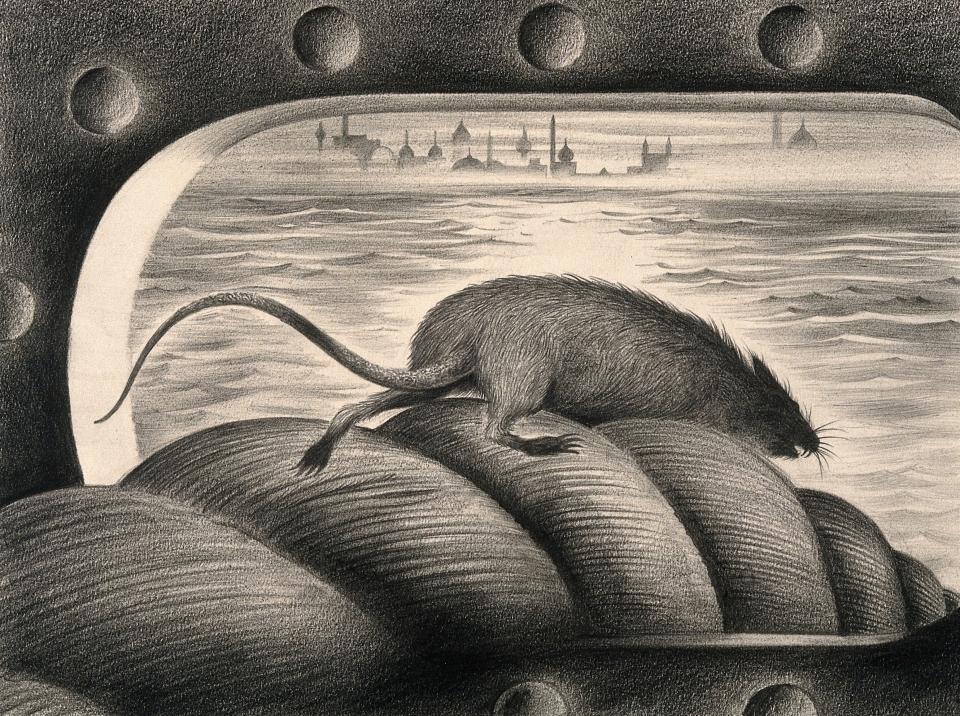
A rat leaving a ship via the mooring rope, thus spreading the plague. Drawing by A. L. Tarter, 1940s.
A rat leaving a ship via the mooring rope, thus spreading the plague. Drawing by A. L. Tarter, 1940s.
Drawing by A. L. Tarter, n.d.
Courtesy of the Wellcome Collection.
Click here to view source.
 This work is licensed under a Creative Commons Attribution 4.0 International License.
This work is licensed under a Creative Commons Attribution 4.0 International License.
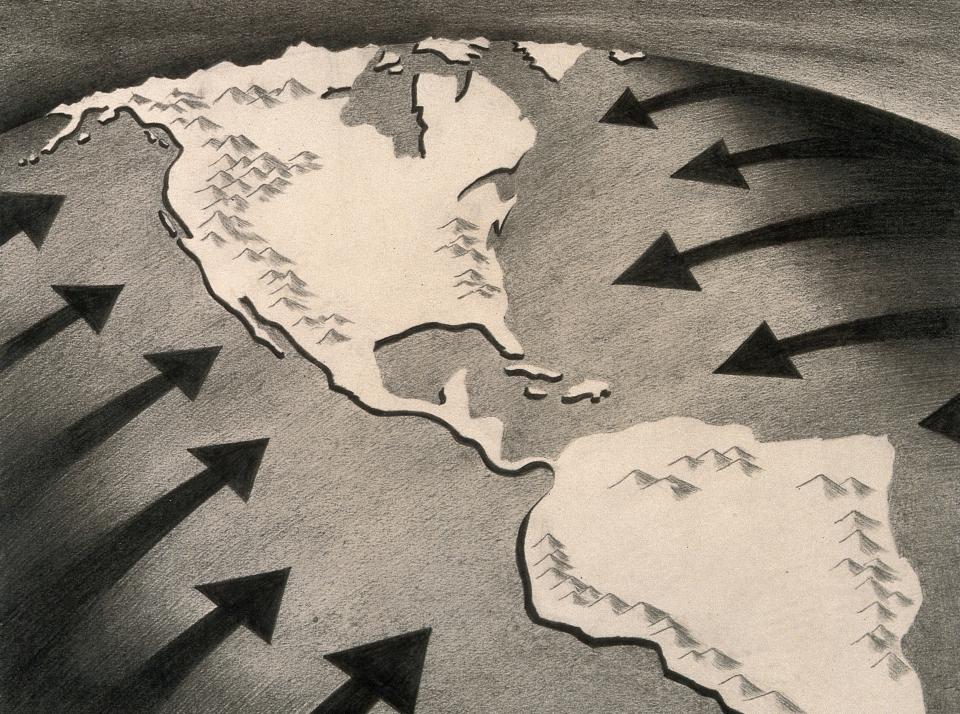
The plague spreads to America. Drawing by A. L. Tarter, 1940s.
The plague spreads to America. Drawing by A. L. Tarter, 1940s.
Drawing by A. L. Tarter, n.d.
Courtesy of the Wellcome Collection.
Click here to view source.
 This work is licensed under a Creative Commons Attribution 4.0 International License.
This work is licensed under a Creative Commons Attribution 4.0 International License.
“No witchcraft, no enemy action had silenced the rebirth of new life,” Carson wrote at the end of her fable about a spring that never arrived. “The people had done it themselves.” She did not blame pesticide deaths merely on some cabal of greedy capitalists or foreign militarists. All kinds of people had some role—rich and poor, men and women, even newborn infants. They were part of the biggest population boom in history, and to feed themselves they demanded more food and fiber. Then they went to war on insects and fungi, a war that, unintentionally of course and with some noble motives, ended by devastating the web of life.
By driving agricultural production to new heights, consumers threatened their own health as well as the health of the planet. (Carson linked rising cancer rates and other modern diseases to the new pesticides.) The ultimate cause, therefore, was not simply a concentration of economic and technological power; it was a deeper and broader cultural drive to conquer nature. While it was true that some powerful agribusiness companies had led the creation of new agricultural chemicals, showing “no humility before the vast forces with which they tamper,” ordinary people bore some responsibility too. Millions of people had gladly bought and used those chemicals or otherwise supported their use. The domination of nature was what they commonly sought, and chaos was what they got.
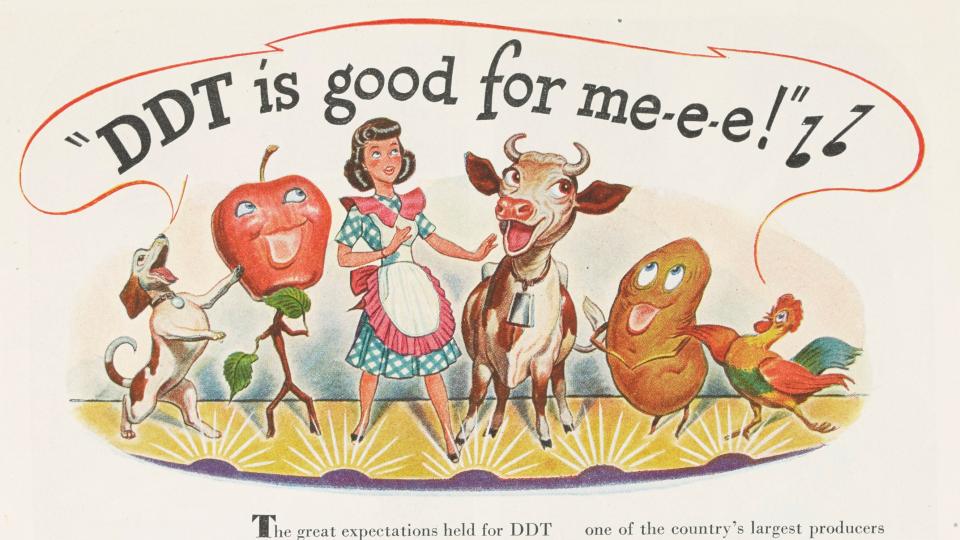
“DDT is good for me-e-e!” Color print magazine advertisement for Pennsalt DDT products. This ad appeared in Time Magazine, 30 July 1947.
“DDT is good for me-e-e!” Color print magazine advertisement for Pennsalt DDT products. This ad appeared in Time Magazine, 30 July 1947.
“DDT Is Good for Me-e-e!,” 30 July 1947.
Courtesy of Science History Institute. Philadelphia.
 This work is licensed under a Creative Commons Public Domain Mark 1.0 License.
This work is licensed under a Creative Commons Public Domain Mark 1.0 License.
So it is in the current pandemic. Once again it is, by and large, all of us—including the anonymous, obscure, and decent people—who have made the world sick. Once more we have done it ourselves. Yet the media is noisy with ethical reductionists who want to fix all the blame on a few. They worry only about the distribution of modern abundance, not its mode of production, and about human security, not the damage we have done to the earth. Then there are super-nationalists, in the United States and China for example, who want to blame the virus on foreigners competing with them for power and wealth and infiltrating their cities. But that cannot be the real story, for COVID-19 is only the latest in a long series of pandemics, and these have originated from many different places on earth.
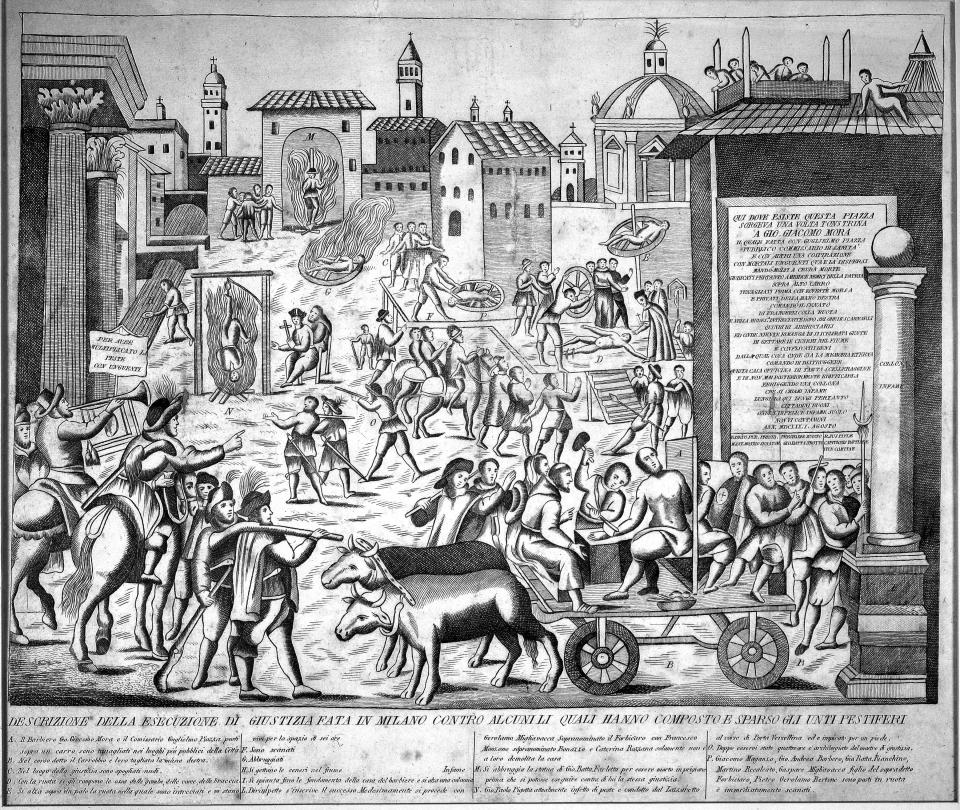
Torture and execution of alleged plague carriers during the plague epidemic at Milan, 1 August 1630. Unknown artist, n.d.
Torture and execution of alleged plague carriers during the plague epidemic at Milan, 1 August 1630. Unknown artist, n.d.
Courtesy of the Wellcome Collection.
Click here to view source.
 This work is licensed under a Creative Commons Attribution 4.0 International License.
This work is licensed under a Creative Commons Attribution 4.0 International License.
Take for example the Justinian plague of the sixth century CE, which killed half the population of Eurasia and northern Africa. Ground zero back then was the city of Constantinople, which had been infected by rodents carrying the bacterium Yersinia pestis (the same bacterium responsible for the Black Death of fourteenth-century Europe, which killed a third of Europeans). Those outbreaks of “the Plague” may have begun in central Asia or northern India, from which tiny, unicellular microorganisms were unwittingly transported by desert caravans and trading ships westward, following the Silk Road or crossing the Black Sea, the Indian Ocean, and the Mediterranean Sea. A similar etiology was repeated in the horror of 1918, when the virus H1N1 (misnamed the “Spanish flu”) was possibly transported from the United States to the battlefields of World War I and points beyond, killing at least fifty million people in all. More recently a rash of epidemics has spread from a multiplicity of points: from Europe (the Marburg virus), Africa (Ebola, HIV), Latin America (Zika, dengue), North America (Hantavirus), and Asia (MERS-CoV, SARS CoV-2). Clearly, there has been no single “evil nation” or “evil class” behind all those epidemics. More sensibly, we should ask what common factors lay behind all of them.
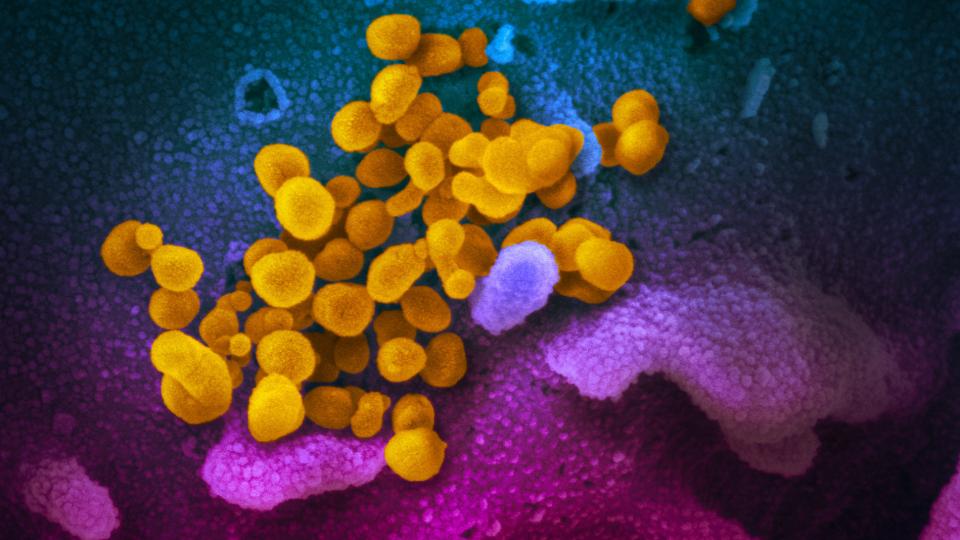
This scanning electron microscope image shows SARS-CoV-2 (yellow)—also known as 2019-nCoV, the virus that causes COVID-19—isolated from a patient in the U.S., emerging from the surface of cells (blue/pink) cultured in the lab.
This scanning electron microscope image shows SARS-CoV-2 (yellow)—also known as 2019-nCoV, the virus that causes COVID-19—isolated from a patient in the U.S., emerging from the surface of cells (blue/pink) cultured in the lab.
Photograph by NIAID, 2020.
Accessed via Flickr on 20 April 2020.
Click here to view source.
 This work is licensed under a Creative Commons Attribution 2.0 Generic License.
This work is licensed under a Creative Commons Attribution 2.0 Generic License.
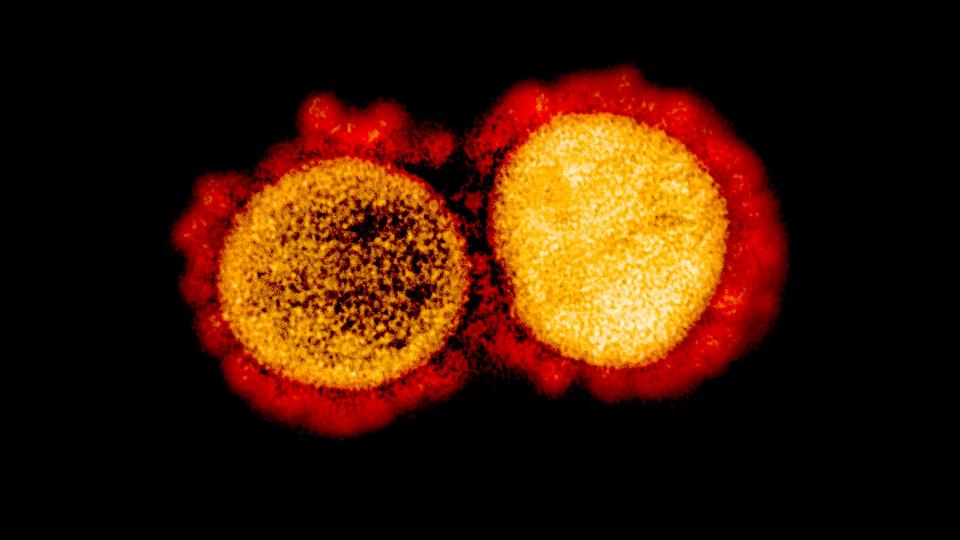
Transmission electron micrograph of SARS-CoV-2 virus particles, isolated from a patient. Image captured and color-enhanced at the NIAID Integrated Research Facility (IRF) in Fort Detrick, Maryland.
Transmission electron micrograph of SARS-CoV-2 virus particles, isolated from a patient. Image captured and color-enhanced at the NIAID Integrated Research Facility (IRF) in Fort Detrick, Maryland.
Photograph by NIAID, 2020.
Accessed via Flickr on 20 April 2020.
Click here to view source.
 This work is licensed under a Creative Commons Attribution 2.0 Generic License.
This work is licensed under a Creative Commons Attribution 2.0 Generic License.


